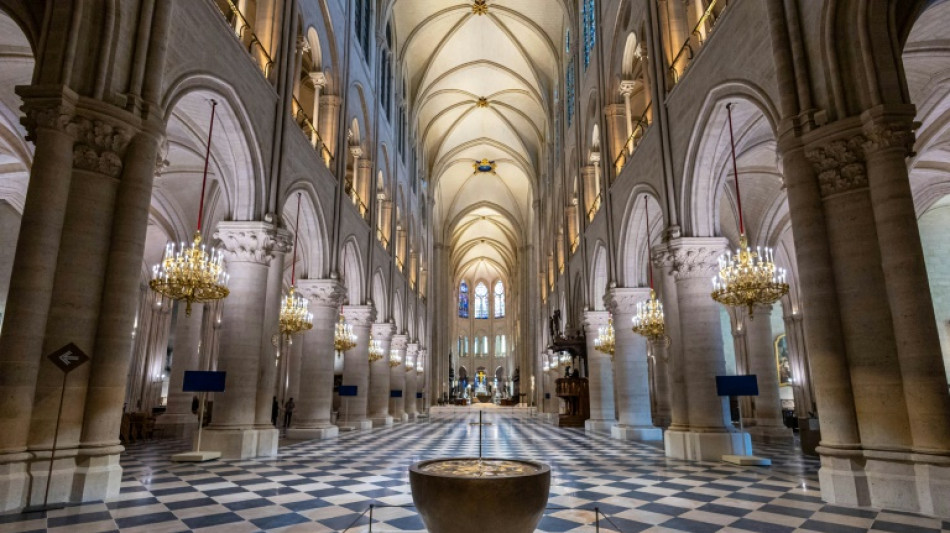
RBGPF
0.1600


France on Friday showed off to the world the gleaming restored interior of Notre Dame cathedral, just over a week before the 850-year-old mediaeval edifice reopens following painstaking restoration after the devastating 2019 fire.
President Emmanuel Macron conducted an inspection of the restoration, broadcast live on television, saying workers had done the "impossible" by healing a "national wound" after the fire on April 19, 2019.
While every effort has been made to remain faithful to the original look of the cathedral, an international team of designers and architects have created a luminous space that has an immediate impact on the visitor.
The floor shimmers and the freshly-cleaned walls dazzle, while a subtle combination of natural and artificial light creates a near theatrical impression.
"You have achieved what was thought impossible," Macron told restoration workers and officials who packed Notre Dame, after he toured the cathedral.
"The blaze at Notre Dame was a national wound, and you have been its remedy through will, through work, through commitment," he said, adding the cathedral's re-opening will be a "shock of hope".
Notre Dame will welcome visitors and worshippers again over the December 7-8 weekend, after a sometimes challenging restoration.
World leaders are expected to attend but the guest list has yet to be revealed.
Macron toured the key areas of the cathedral, including the nave, choir and chapel, and spoke to experts.
"Sublime," said a visibly pleased Macron, who was accompanied by the archbishop of Paris, Laurent Ulrich, plus France's culture minister, the mayor of Paris and other officials.
"It is much more welcoming," he added, praising Notre Dame's pale-coloured stones and saying everyone involved in the reconstruction should "be proud".
- 'Insane challenge' -
After the devastating fire Macron set the ambitious goal to rebuild Notre Dame within five years and make it "even more beautiful" than before, a target that the French authorities say has been met.
The "building site of the century" was a "challenge that many considered insane", Macron has said.
Some 250 companies and hundreds of experts were brought in for restoration work costing hundreds of millions of euros.
All 2,000 people who contributed to the effort had been invited to Friday's event.
The restoration cost a total of nearly 700 million euros (more than $750 million at today's rate).
It was financed from the 846 million euros in donations that poured in from 150 countries in a surge of solidarity.
The 19th-century gothic spire, which collapsed dramatically in the blaze, has been resurrected with an exact copy of the original.
The stained windows have regained their colour, the walls shining after fire stains were cleaned and a restored organ is ready to thunder out again.
Unseen to visitors is a new mechanism to protect against future fires, a discreet system of pipes ready to release water in case of a new disaster.
Notre Dame, which welcomed 12 million visitors in 2017, expects to receive an even higher figure of 14 to 15 million after the reopening, according to the church authorities.
French ministers have also floated the idea of charging tourists an entrance fee to the site but the Paris diocese has said free admission was an important principle to maintain.
- Reopening ceremony -
Macron had hoped to speak inside Notre Dame to mark the reopening on December 7 but after negotiations with the diocese, he is now set to speak in the forecourt only.
France is by its constitution a secular country with a strict division between church and state.
Sunday December 8 will see the first mass and consecration of the new altar.
Macron said in December 2023 he had invited Pope Francis to the reopening of the cathedral but the head of the Catholic church announced in September, to the surprise of some observers, that he would not be coming.
Instead, the pontiff is making a landmark visit the following weekend to the French island of Corsica.
The French Catholic church has in recent years been rocked by a succession of sexual abuse allegations against clerics, including most recently the monk known as Abbe Pierre who became a household name for providing aid to the destitute.
Over five years on, the investigation into what caused the fire is ongoing, with initial findings pointing to an accidental cause such as a short circuit, a welder's torch or a cigarette.
K.Tanaka--JT